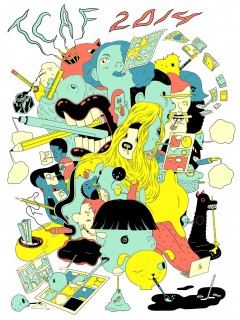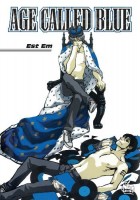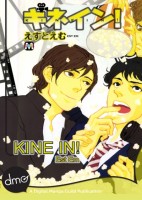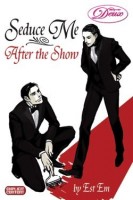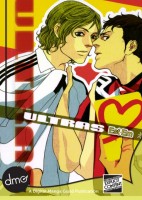Last year I attended the Toronto Comic Arts Festival (TCAF) for the very first time. It was an event that I had wanted to go to for years and I had such a fabulous time that I immediately began planning to return. TCAF is the only comics festival that I have ever been to so I can’t really compare it to others, but it is fantastic and I can’t recommend it enough. I certainly plan on going every that I possibly can at this point.
Last year I was only there for the main festival on Saturday and Sunday, but this year I pulled into Toronto on Thursday evening which gave me plenty of time to explore the city itself. After figuring out how to use Toronto’s streetcar system (I’ve never ridden a streetcar before) my “early” arrival allowed me to attend the opening reception of Toshio Saeki’s art exhibition at Narwhal Projects. Saeki is described as the “Godfather of Japanese Eroticism.” The gallery was a showing of a selection of his original drawings and silkscreen prints. They were beautiful, disconcerting, erotic, and surreal works. I’m very glad I had the opportunity to see them in person.
Friday was my “free” day in Toronto. While I was wandering all over the city, I made sure to make my way down to The Beguiling Books & Arts. Last year I got there a few minutes before it closed, so I was looking forward to spending a more reasonable amount of time exploring the store this year. The Beguiling is one of the best comic stores I’ve ever been to. It has a fantastic selection of materials and a marvelous staff. I highly recommend anyone visiting Toronto to check it out. The event that I was looking forward to on Friday was the Manga Mixer Night hosted by Sparkler Monthly at the TRANZAC Club. I sadly missed out on the gathering last year, and one of my TCAF goals for this year was to overcome some of my anxieties and to try to be a little more social, so to the mixer I went! And I’m glad that I did. I had a good time and Kuriousity‘s Lissa Pattillo and I were beautiful wallflowers together. We had a very nice conversation about manga, blogging, and TCAF.
Over the course of the festival I had the opportunity to briefly meet several other of my online friends in person: manga translator and all around awesome person Jocelyne Allen, my fellow Manga Bookshelf cohort Sean Gaffney, and the great A-run Chey who somehow managed to pick me out of a crowd. I certainly made some progress this year in the socialization department, but I still didn’t have the nerve to introduce myself to Deb Aoki and Erica Friedman, who were both kept very busy moderating various panels, or to Vertical’s Ed Chavez even though I was standing next to each of them at some point during the festival. Next time I’ll make it happen! I know there were at least a few other manga and comics bloggers at TCAF—like Brigid Alverson and Alexander Hoffman, among others—but I missed them, too.
Saturday was when the main festival actually began. Last year I didn’t get to spend as much time in the exhibitor area as I would have liked, so I got up bright and early on Saturday in order to visit as many artists and publishers as I could first thing in the morning. This turned out to be a good decision, because the exhibitor area seemed to only get busier and busier throughout the day. I couldn’t see everything before the Saturday panels started, but by the end of the day I managed to visit most of the tables that I wanted. Sadly, there were a few things that I was hoping to get that were sold out by the time I was able to make my way to the artists’ respective tables. But at least that meant that the creators were doing well, and I was very glad to see their success. While I went into TCAF knowing there were certain things that I wanted to pick up, I also allowed myself the opportunity to splurge on a few random items that I hadn’t even heard of before and discovered some great comics in the process. And of course, I also managed to compile a rather lengthy list of things that I wanted to check out later, too. I continue to be very impressed by both the quality and variety of creators and art at TCAF.
I attended four panels on Saturday. “What Do Women Want? Writing Comics for a Female Audience,” was moderated by Chromatic Press’ Lianne Sentar and featured Laura Lee Gulledge, Kate Leth, Joan Reilly, and Noelle Stevenson. It was an excellent panel looking at men and women and masculinity and femininity in comics and the North American comics industry. Generally, comics readers are assumed by the industry to be both male and straight and so that audience is the one that has traditionally been catered to. There have always been female readers but recently there have been more demands for a wider variety in comics, perhaps due in part to what the panelists called the “Sailor Moon Generation.” These are the women, and men, who were exposed to female-friendly Sailor Moon when they were younger and who are now old enough to create the types of comics that they want to see or are in the position to support and encourage other upcoming creators who want something more than the industry’s default. The key to the discussion was the importance of variety in comics and that great stories will attract all sorts of readers regardless of their intended audience.
“Comics Design and History” focused on the physical design, production, and presentation of graphic novels. The panel was moderated by Chris Randle and included designers Tracy Hurren from Drawn & Quarterly, Fawn Lau from Viz Media, and Chip Kidd, who has designed books for Vertical and PictureBox among many other publishers. They each chose three book designs to discuss and talked about some of the decisions that go into the design process. For example, one of the first steps when a comic is being translated into another language is to determine whether the original cover is suited for the new demographic. Unflipped manga has the potential to be accidentally displayed with the back cover as the front, so Kidd very deliberately created a design for Bat-Manga!: The Secret History of Batman in Japan that was interesting and informative regardless of which direction the book was facing. One of the series that Lau discussed was Taiyo Matsumoto’s Sunny, talking about the choices that went into its deluxe presentation. One of the biggest challenges in book design is achieving a balance between production values and the budget, and then finding a printer that can actually produce it.
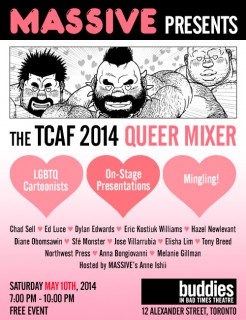
TCAF 2014 Queer Mixer presented by MASSIVE
Considering the fantastic lineup—Jess Fink, Michael DeForge, C. Spike Trotman, HamletMachine, Graham Kolbeins, Katie Skelly, Ryan Sands—I should have known that “Contemporary Erotic Comics” was going to be a popular panel. It was held in one of the smallest venues and was completely packed, but it was absolutely worth squeezing into the crowd. Chris Randle was the moderator for this panel as well. The panelists discussed their first experiences with erotic comics (manga and doujinshi were frequently cited), the challenges of working in and making a living off of pornography, and some of the current trends in sex comics as a genre. The panel’s emphasis on the need for variety and different perspectives dovetailed nicely with parts of the “What Do Women Want?” discussion. Kolbeins, who has been critical to the efforts to bring gay manga to English-reading audiences, was able to provide fascinating insights into some of the difference between Japanese and Western porn comics industries. In Japan, pornography is often meant to exclusively be pornography; adding any sort of message or social commentary can be seen as watering it down. On the other hand, in the West sex comics often allow creators to address issues other than sex; as long as certain plot requirements are met, they are more or less free to do whatever they want with their comics.
The last panel that I attended on Saturday, moderated by Deb Aoki, was “Women in Manga!” The panel included all of this year’s mangaka who were featured guests at TCAF: Moyoco Anno, est em, and Akira Himekawa (A. Honda and S. Nagano, a two-women team). All four of them admitted that they brought their work along with them on the trip; they may be traveling, but they still had deadlines to meet. Even though they are women, they said that they are largely treated the same as their male counterparts when working in seinen. (In many cases, readers don’t even realize that they are women!) However, working in shounen used to present more hurdles, though it’s not as difficult now as it once was. In the end, readers care more about the content than the mangaka’s gender. Regardless of the genre or demographic that they are working in, the panelists normally receive respect. The exception to this would be boys’ love which is somewhat looked down upon. est em felt this was because that instead of the more usual manga contests which award the creators with a series, boys’ love mangaka often become professionals through their doujinshi and this is seen as a sneaky, backdoor way of breaking into the manga industry.
One of the heartbreaking things about TCAF is that there is so much great programming that it’s impossible to attend it all and hard decisions must be made. Sadly, “Women in Manga!” conflicted with the “Queering Comics – LGBTQ identity in comics and graphic novels” panel which I really wanted to attend. Since I couldn’t make it to the queer comics panel, I decided to show up for the TCAF Queer Mixer at Buddies in Bad Times Theatre instead. Now, I don’t generally go to things like parties and mixers, but I was enticed by the promise of on-stage presentations and interviews. And I wasn’t disappointed. Anne Ishii of MASSIVE made a fabulously entertaining host and more than a dozen of the queer creators who were at TCAF this year were spotlighted as part of the event. I was already familiar with some of them and their work, but others were new to me. And I’ll admit, it was pretty awesome to just be in the same room with a bunch of other amazing queer folk. One of the best things about TCAF is how marvelously inclusive it is, and the annual Queer Mixer is representative of that.
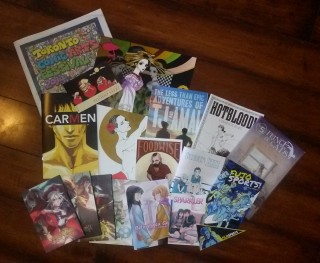
My 2014 TCAF haul
Then came Sunday, the last day of the main festival. Also known as “Ash’s day of manga.” I made it to three events, each one focusing on the festival’s featured mangaka. First thing in the morning was Moyoco Anno’s Spotlight with Ed Chavez. Probably not too surprisingly, Vertical’s releases of Anno’s manga—Insufficient Direction, Sakuran, and the soon to be published In Clothes Called Fat—were used as a jumping off point for the discussion. Anno talked about her approach to writing seinen, choosing to focus on what she as a woman can bring to the demographic rather than trying to compete in the same areas where men could do just as well. As for shoujo, she doesn’t feel that it has changed much over the last twenty years; it still follows the same unrealistic tropes, especially in regards to love. She feels that the large gap between real relationships and how they are portrayed in manga can sometimes be problematic for readers. When asked, she sweetly replied that her favorite character to draw was Director-kun, her husband Hideaki Anno (who also happened to be in attendance).
Those who stayed for the entire Moyoco Anno Spotlight were at a slight disadvantage when it came to the signing that immediately followed. I was the first person put in the rush line for her signing, but sadly I still didn’t get the chance to personally meet Anno. However, this did mean that I had time to walk over to Toronto’s Japan Foundation in time for Akira Himekawa in Conversation. The two women, who are best known for their Zelda manga, are celebrating their thirtieth year of collaboration and were being interviewed by Deb Aoki. They were both incredibly engaging and enthusiastic about their work. I actually haven’t read very much of Himekawa’s manga, but I’ll certainly be making a point to now. And after seeing examples of some of their current series, I really hope that more of their manga will be licensed in English in the future. I love the Zelda franchise, but Himekawa’s recent work, much of it in full-color, simply looks gorgeous. While I was at the Japan Foundation, I was also able to see the Seiji Ozawa Photography Exhibition—a showcase of archival materials focusing on the young, Japanese music director of the Toronto Symphony Orchestra from 1965 to 1969—which was great.
The Japan Foundation also sponsored an interview with Yohei Sadoshima, whose literary agency represents Moyoco Anno among many other creators, about the future of the manga industry. Unfortunately this conflicted with the est em Spotlight. As a huge fan of est em, there was no way I was going to miss her panel. Erica Friedman was the moderator and it actually ended up being one of the best interviews that I attended at TCAF this year, making it a great way to end the festival. est em got her start as a professional mangaka through boys’ love after being approached by an editor who was intrigued by her doujinshi. Interestingly enough, she hadn’t actually read much mainstream boys’ love, which may partly explain why her manga tends to be somewhat unusual. Although est em is probably best know for her atypical boys love manga, her current series—Golondrina and Ippo—are both seinen manga. I think that Viz is probably my only hope, but someone please license Golondrina for a print release! est em explains that the reason her work is quirky is because it incorporates what she personally finds to be beautiful or interesting. She especially enjoys exploring and working with themes that address the spaces in between two opposing forces. (Over at Okazu, Erica recently posted an excellent and much more thorough write-up of the est em Panel at TCAF.)
So there you have it! And that’s just scratching the surface of this year’s festival experience. In short: TCAF 2014 was phenomenal. The guests were amazing. The programming was fantastic. I hope that I’ll be able to go again next year. That’s the plan, anyway!

